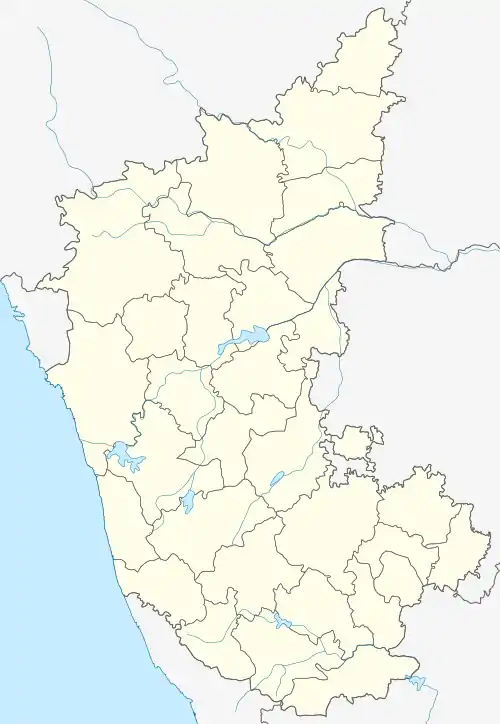Barkur
Barkur is a cluster of three villages, Hosala, Hanehalli, and Kachoor, in the Brahmavara taluk, Udupi district of Karnataka state in India. The place is located on the bank of River Seetha. It is also called as 'temple town'.[1]
Barkur | |
|---|---|
Town | |
 Barkur Location in Karnataka, India  Barkur Barkur (India) | |
| Coordinates: 13.4668°N 74.7498°E | |
| Country | |
| State | Karnataka |
| District | Udupi District |
| Languages | |
| • Official | Kundagannada, Tulu |
| Time zone | UTC+5:30 (IST) |
Barkur is located 16 km from Udupi, another ancient city, and 3 km from Brahmavara, a taluk of Udupi. The Seetha River flows through Barkur and joins the Arabian Sea.[2]
History
Barkur was the ancient capital of the Alupa kingdom. It was known as Barakanyapura and later as Barakkanur.[3] The rulers were known as Tuluva rulers. They spoke Tulu language. Many ancient inscriptions found in Barkur are in Tulu language. These are an essential part of history of Tulunadu . The Coastal Town of Barkur was also a flourishing port in the 15th and 16th centuries. At that time Barkur was referred as Capital of Tulunadu.
Apart from the Alupa rulers, Alupa rulers made Barkur as their capital. Archaeological findings suggest that Barkur was a province under the Vijayanagar Empire in the 14th century A.D. Pandarideva was the Governor of this province under the regime of Harihara II.[4] There are remains of two forts built by the Alupas and Vijayanagara governors. It was also a sub capital of the Hoysala kings for some period.
Temple Architecture
The temples at Barkur have a distinct architecture. The sloping terracotta-tiled roofs bear resemblance to the temples of Kerala, but they do not have gopurams, a common feature of the Dravidian style South Indian temples.
- Chowlikere Ganapathy Temple
Chowlikere Ganapathy Temple was constructed 900 years back,[3] during the Chola Period. The Bairagi Ganapathy Temple is entirely hewn out of stone with a slanted stone roof and etched stone pillars. The stone walls of this temple display beautiful sculptures and it is apparent that this mammoth structure has withstood the ravages of time. The Panchalingeshwara Temple, dedicated to Lord Shiva, is Barkur's largest temple, and is one of the oldest in the town. Its double-storied gateway, with a pillared verandah on either sides, is most alluring. The rear side of the temple has an elephant-back-like curvilinear structure. The pillars that surround the circumambulatory path of the temple are decorated with carvings depicting mythological characters.
- Kathale Basadi

A 20-feet monolithic stone pillar is erected at the entrance.[3] The temples were elegantly designed with carvings and embellishments, but are now in ruins. The twenty-four dents in the stone are the only evidence of the existence of idols of the twenty-four Jain thirthankaras.[5] There are three main structures in a big courtyard with a victory pillar at the entrance. Archaeologists say that they were built between the 8th and 12th century A.D. Built by the Alupa rulers, the Jain Basadi, unlike most South Indian temples built in the Dravidian style, does not have a gopuram. The sanctum sanctorum is surrounded by stone walls otherwise known as Prangan, with sloping stone pillars over it. The original Mahavira idol was destroyed but has been replaced by stone tablets with animal figures that are a later addition.[2]
Katthale Basadi consists of Navranga with Nagkaali, Shiva, Vishnu and Jain deities with separate temples. It proves the existence of changing kingdoms with various rulers trying to control the city both politically and in terms of religion.[6]
Barkur Fort
The Barkur fort was built by Harihara I, founder of the Vijayanagara Empire. The Barkur fort is spread across 20 acres of land. Inside the fort there are ruins of the kingdom. There are pillars used to tie horses and elephants which formed the part of the army. This fort was excavated several years ago by the archaeologists in a few acres of land, which is now an excursion site.[7]
See also
References
- "What's the buzz in Barkur". Deccan Herald. 3 August 2019. Retrieved 18 December 2019.
- "Immersed in heritage". The Hindu. 7 July 2012. Retrieved 13 January 2015.
- "Ruins of Barkur". Trayaan. 15 January 2013. Retrieved 1 December 2016.
- "14th century bronze idols discovered". The Hindu. 5 January 2014. Retrieved 5 January 2015.
- "It is now a window to the past". Deccan Harald. 30 December 2014. Retrieved 31 December 2014.
- "The ruins of a long lost kingdom of glory: Barkur". news Karnataka. 30 December 2014. Retrieved 31 December 2014.
- "Take a tour to Mangalore and Barkur". New Indian Express. 2 February 2012. Retrieved 5 January 2015.
External links
| Wikimedia Commons has media related to Barkur. |